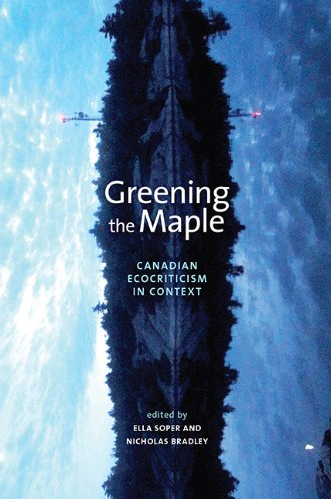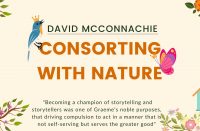The arrival of Ella Soper and Nicholas Bradley’s anthology, Greening the Maple: Canadian Ecocriticism in Context, marks the solidification of ecocriticism in this country. Ecocriticism is defined by the editors “in very general terms as the investigation of the many ways in which culture and the environment . . . are interrelated and conceptualized.” This field of literary studies is exciting from an environmental perspective because it “has sought since its inception to make the study of literature . . . relevant to the innumerable environmental crises, local and global, that characterized the end of the twentieth century and that threaten to define the twenty-first.” The vibrant essays in this collection show just how relevant Canadian literature can be to environmental debates and also how an ecocritical attention to language, form and representation can elucidate literature and culture’s often implicit environmental commentary.
This 569-page compendium will serve as a benchmark for Canadian ecocriticism. It includes twenty-four essays, an admirable introduction, an afterword on the future of the field, and an appendix that provides an institutional history. The selected essays, written between 1965 and 2013, are wide-reaching, relying on various ecocritical perspectives to analyze literary and cultural forms from the nineteenth century onward. However, the editors warn that their preference for essays that address literary texts has resulted in the exclusion of general ecocritical essays and pieces by indigenous authors on the topics of environmental knowledge and politics. They have also excluded a large body of environmental criticism written by a worthwhile group of creative writers, thus noting that “Canadian ecocriticism as practiced by academic critics should be recognized, then, as only one element of a wider and ongoing Canadian literary-ecological conversation.”
Sections one and two suggest that Canadian ecocriticism has emerged out of two areas of study: the first, a uniquely Canadian understanding of literature and the environment between the 1960s and 1980s; and the second, American ecocriticism, which emerged in the 1990s. Margaret Atwood and Northrop Frye loom large in section one, and throughout the rest of the collection for that matter, and are praised by the editors for doing much for Canadian ecocriticism despite their thematic approach. But, just as Atwood and Frye have generated much discussion in this collection, so has American ecocriticism which has been viewed with both excitement and wariness by Canadian ecocritics such as Susie O’Brien and Laurie Ricou.
The middle sections of the anthology address landscape, postcolonialism and animals. Section three’s essays, by Jenny Kerber on nature writing and border theory, Catriona Sandilands on the rhetoric of national park festivals, and Cheryl Lousley on fictional characters’ understanding of the land, reveal the many ways that ecocritics examine landscapes. Section four offers three essays on “cross-cultural encounters,” of which Stephanie Posthumus and Élise Salaün’s co-authored overview of environmental literature and thought in Quebec is particularly useful for readers who are unfamiliar with Québécois perspectives. Although the animal is not generally the domain of ecocriticism, section five suggests that Canadian ecocriticism has something to offer to this study. Pamela Banting’s essay proves this to be so. The final section titled In Full Bloom: New Directions in Canadian Theory falls short despite the quality of each essay because the attention to poetry and drama suggests, perhaps misleadingly, that Canadian ecocritical theory has left the novel and non-fiction behind.
Greening the Maple is a must read for those interested in literature and the environment. The collection demonstrates the uniqueness and worth of Canadian ecocriticism and its various origins and trajectories. While environments often eclipse national borders, and ecocriticism and environmentalism are often local or transnational, this collection’s national scope is successfully defended by the editors as providing a framework that can complement other perspectives. It is worth remembering that this is the first Canadian anthology of ecocriticism, despite the strength, depth and diversity of the field, which this collection showcases more than competently. I wager that this wonderful anthology will soon be remembered as the Canadian equivalent to the influential American anthology The Ecocriticism Reader: Landmarks in Literary Ecology. Like The Ecocriticism Reader, which marked the arrival of American ecocriticism, Greening the Maple will mark the arrival of Canadian ecocriticism.
Greening the Maple: Canadian Ecocriticism in Context, Ella Soper and Nicholas Bradley, eds, Calgary: University of Calgary Press, 2013.
Reviewer Information
Alec Follett is an enthusiastic birdwatcher whose PhD research, at uGuelph, explores the crossroads of environmental knowledge and environmental justice in Ontarian literature.













